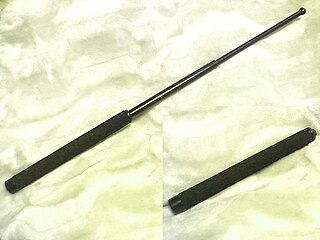
A salute is usually a formal hand gesture or other action used to display respect in military situations. Salutes are primarily associated with the military and law enforcement, but many civilian organizations, such as Girl Guides, Boy Scouts and the Salvation Army use formal salutes. Ordinary civilians also salute informally to greet or acknowledge the presence of another person, such as a tip of the hat or a hand wave to a friend or neighbour.

In military organizations, a colour guard is a detachment of soldiers assigned to the protection of regimental colours and the national flag. This duty is highly prestigious, and the military colour is generally carried by a young officer (ensign), while experienced non-commissioned officers are assigned to the protection of the national flag. These non-commissioned officers, accompanied in several countries by warrant officers, can be ceremonially armed with either sabres or rifles to protect the colour. Colour guards are generally dismounted, but there are also mounted colour guard formations as well.
A court-martial or court martial is a military court or a trial conducted in such a court. A court-martial is empowered to determine the guilt of members of the armed forces subject to military law, and, if the defendant is found guilty, to decide upon punishment. In addition, courts-martial may be used to try prisoners of war for war crimes. The Geneva Conventions require that POWs who are on trial for war crimes be subject to the same procedures as would be the holding military's own forces. Finally, courts-martial can be convened for other purposes, such as dealing with violations of martial law, and can involve civilian defendants.

Self-defense is a countermeasure that involves defending the health and well-being of oneself from harm. The use of the right of self-defense as a legal justification for the use of force in times of danger is available in many jurisdictions.
The right to silence is a legal principle which guarantees any individual the right to refuse to answer questions from law enforcement officers or court officials. It is a legal right recognized, explicitly or by convention, in many of the world's legal systems.
The presumption of innocence is a legal principle that every person accused of any crime is considered innocent until proven guilty. Under the presumption of innocence, the legal burden of proof is thus on the prosecution, which must present compelling evidence to the trier of fact. If the prosecution does not prove the charges true, then the person is acquitted of the charges. The prosecution must in most cases prove that the accused is guilty beyond a reasonable doubt. If reasonable doubt remains, the accused must be acquitted. The opposite system is a presumption of guilt.

Desertion is the abandonment of a military duty or post without permission and is done with the intention of not returning. This contrasts with unauthorized absence (UA) or absence without leave, which are temporary forms of absence.
In the United Kingdom, the Judge Advocate General is a judge responsible for the Court Martial process within the Royal Navy, British Army and Royal Air Force. As such the post has existed since 2006; prior to this date the Judge Advocate General's authority related to the Army and the RAF while the Judge Advocate of the Fleet was the equivalent with regard to the Royal Navy.

A summary execution is an execution in which a person is accused of a crime and immediately killed without the benefit of a free and fair trial. Executions as the result of summary justice are sometimes included, but the term generally refers to capture, accusation, and execution all conducted within a very short period of time, and without any trial. Under international law, refusal to accept lawful surrender in combat and instead killing the person surrendering is also categorized as a summary execution.

The kirpan is a curved, single-edged blade that Khalsa Sikhs are required to wear as part of their religious uniform, as prescribed by the Sikh Code of Conduct. Traditionally, the kirpan was a full-sized talwar sword around 76 cm in length; however, British colonial policies and laws introduced in the 19th century reduced the length of the blade, and in the modern day, the kirpan is typically manifested as a dagger or knife. According to the Sikh Code of Conduct, "The length of the sword to be worn is not prescribed". It is part of a religious commandment given by Guru Gobind Singh in 1699, founding the Khalsa order and introducing the five articles of faith which must be worn at all times.

Courts-martial of the United States are trials conducted by the U.S. military or by state militaries. Most commonly, courts-martial are convened to try members of the U.S. military for violations of the Uniform Code of Military Justice (UCMJ). They can also be convened for other purposes, including military tribunals and the enforcement of martial law in an occupied territory. Federal courts-martial are governed by the rules of procedure and evidence laid out in the Manual for Courts-Martial, which contains the Rules for Courts-Martial (RCM), Military Rules of Evidence, and other guidance. State courts-martial are governed according to the laws of the state concerned. The American Bar Association has issued a Model State Code of Military Justice, which has influenced the relevant laws and procedures in some states.

The judicial system of Turkey is defined by Articles 138 to 160 of the Constitution of Turkey.

In France, there is an ongoing social, political, and legal debate concerning the wearing of the hijab and other forms of Islamic coverings in public. The cultural framework of the controversy can be traced to France's history of colonization in North Africa, but escalated into a significant public debate in 1989 when three girls were suspended from school for refusing to remove their headscarves. That incident, referred to in France as l'affaire du foulard or l'affaire du voile, initially focused the controversy on the wearing of the hijab in French public schools. Because of the wide-ranging social debates caused by the controversy, l'affaire du foulard has been compared to the Dreyfus affair in its impact on French culture.

The Presidential Security Force of Indonesia is one of the Central Executive Agencies of the Indonesian National Armed Forces responsible for proximate security and escort towards the head of state and VVIP in Indonesia, which includes the President, Vice President with their immediate families, former Presidents and Vice Presidents, and visiting foreign heads of state. Paspampres is based in Jakarta, and its personnel are drawn from deputized best-chosen officers, soldiers, seamen, marines, and airmen from special forces and/or special units within the Indonesian National Armed Forces (TNI). It is commanded by a two-star military general.
Baha Mousa was an Iraqi man who died while in British Army custody in Basra, Iraq in September 2003. The inquiry into his death found that Mousa's death was caused by "factors including lack of food and water, heat, exhaustion, fear, previous injuries and the hooding and stress positions used by British troops - and a final struggle with his guards". The inquiry heard that Mousa was hooded for almost 24 hours during his 36 hours of custody by the 1st Battalion of the Queen's Lancashire Regiment and that he suffered at least 93 injuries before his death. The report later details that Mousa was subject to several practices banned under both domestic law and the Geneva Conventions. Seven British soldiers were charged in connection with the case. Six were found not guilty. Corporal Donald Payne pleaded guilty to inhumane treatment of a prisoner and was jailed for a year and dismissed from the Army. On 19 September 2006 with his guilty plea to inhumane treatment of Mousa, Payne became the first British soldier to admit to a war crime.
Human rights violations were committed by the warring sides during the second war in Chechnya. Both Russian officials and Chechen rebels have been regularly and repeatedly accused of committing war crimes including kidnapping, torture, murder, hostage taking, looting, rape, decapitation, and assorted other breaches of the law of war. International and humanitarian organizations, including the Council of Europe and Amnesty International, have criticized both sides of the conflict for blatant and sustained violations of international humanitarian law.
The 1897 pattern infantry officers’ sword is a straight-bladed, three-quarter basket-hilted sword that has been the regulation sword for officers of the line infantry of the British Army from 1897 to the present day.
The right to silence in England and Wales is the protection given to a person during criminal proceedings from adverse consequences of remaining silent. It is sometimes referred to as the privilege against self-incrimination. It is used on any occasion when it is considered the person being spoken to is under suspicion of having committed one or more criminal offences and consequently thus potentially being subject to criminal proceedings.

The military courts of the United Kingdom are governed by the Armed Forces Act 2006. The system set up under the Act applies to all three armed services: the Royal Navy (RN), the British Army, and the Royal Air Force (RAF), and replaces the three parallel systems that were previously in existence.

Tuckers Solicitors LLC, known as Tuckers Solicitors, is a national criminal defence firm that has particular specialisation in serious crime, extradition, martial and military law, civil liberties, human rights, cyber crime and is one of the largest law firms headquartered in London. The firm featured in series of television shows about crime and disorder on national channels and has appeared on national news, commenting on various legal affairs.












